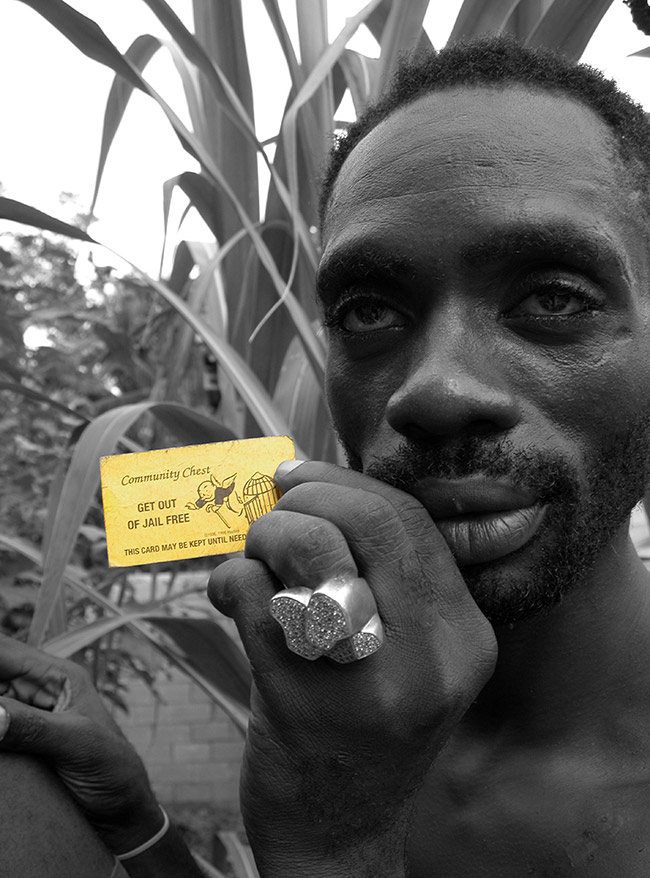The Skatalites: The Birth of a Genre
Originally published in 2003, David Katz’s Solid Foundation: An Oral History of Reggae has come to be an essential resource when it comes to Jamaican music. Earlier this year Katz revised and expanded the book, most notably covering the post-“Sleng Teng” era of the mid-’80s up until the new millennium. It also has the stunning, rarely seen photos on actual photo paper for the first time.
To celebrate its re-release, Katz has graciously allowed us to print an excerpt from the book’s revised second chapter about the year and change in which The Skatalites birthed a new genre, made some massive records and quickly broke up.
The Skatalites hold the distinction of being the act most closely associated with the ska form. The group was officially together for only 14 months from June 1964, but most of the band members had played together regularly since the late ’40s. The nucleus included tenor saxophonist Roland Alphonso, alto saxophonist Lester Sterling, trombonist Don Drummond, trumpeter Johnny “Dizzy” Moore, drummer Lloyd Knibb, bassist Lloyd Brevett, rhythm guitarist Jerry Haynes (AKA Jah Jerry) and pianist Jackie Mittoo.
Despite being at first opposed to the idea, and wary of the ska form in general, the gifted tenor saxophonist and arranger Tommy McCook was eventually persuaded to lead the band by Coxsone Dodd following an eight-year stint leading a jazz group in the Bahamas.
Roland Alphonso said that several core members first played together on the Kingston Pier near the informal street fair and gambling area dubbed Coney Island, and also performed at night spots like the Orange Bowl. “We met each other as teenagers,” Alphonso revealed on a trip to London, shortly before his death in 1998. “Knibb was living at West Street, Brevett was living with his dad, and I was living in Jones Town. We were playing Coney Island six nights a week.”
After their first performance as The Skatalites at the Hi Hat club in Rae Town, the group was soon in demand all over town. Their subsequent residence at the Bournemouth Club, where Lee Perry often joined them on percussion, is legendary for its electrifying performances. This intensity was captured on their studio recordings, mostly cut for Coxsone Dodd, many of which encapsulate the best of ska’s musical possibilities.
Upbeat Skatalites numbers such as “Tear Up” (based on Mongo Santamaria’s “Fat Back”), with Alphonso’s fast solo flourishes, seemed to reflect the optimism of the newly independent island; others, like the raucous “Ball of Fire” and “Guns of Navarone,” simply hold unbridled musical heat. McCook’s compositions, such as “Cow and Gate,” tended toward the spacious, as did his understated solos, which often favoured the lower notes of the scale.
When McCook and Alphonso traded solos on numbers like “Black Sunday,” “Trotting In” and “Hot Cargo,” the contrast was always invigorating; Moore and Sterling, though more in the background, also contributed enthralling solos on songs such as “Killer Diller” and “Beardman Ska,” the latter an adaptation of “Live It Up” by American boogie pianist, Ernie Freeman.
As with ska itself, The Skatalites’ music was created from a pool of disparate influences. Group members explain that some of their biggest hits at Studio One were based on Latin tunes that Coxsone asked them to adapt. “‘El Pussy Cat’ come from Cuba,” Roland noted, referring to the Mongo Santamaria original. “Coxsone give it to me and say: ‘Rolie, write this tune now’ – and I wrote it.”
“Coxsone used to use a lot of Cuban tunes and we would write the tune in ska form,” Lloyd Knibb recalled. “We would generally get those tunes, because a staccato thing was happening in ska.”
Brevett mentioned Santamaria’s El Pussy Cat album as particularly important, since it contained “Hammer Head,” which the Skatalites turned into the hit “Phoenix City,” as well as the title track, as noted above. In fact, for Coxsone, they adapted at least a dozen numbers by the Cuban-born, US-based percussionist. “We play the songs as it had been played,” Roland cut in, “but we arrange it and play the ska thing our style. We don’t copy the solos.”
Jazz was always the biggest source of inspiration for The Skatalites and the members covered songs that moved them, such as Roland’s take on Horace Silver’s “Forest Flowers” or his adaptation of Duke Ellington’s “Caravan” as “Skaravan.” Alphonso spoke of his joy at sharing the stage with Count Basie’s band in Nassau, and gave John Coltrane his utmost admiration. “Coltrane is my man, and I respect him and honour him because his songs is on earth.” Lester Sterling named Miles Davis, Dizzy Gillespie, Cannonball Adderley and Sonny Stitt as musicians he was thrilled to see performing.
Although the bulk of their work was recorded at Studio One, The Skatalites also cut material for the other leading producers of the ska years. “We didn’t sign any contracts with anyone, so we were free,” Alphonso stated. “We work with Duke Reid and King Edwards also. We did some for Prince Buster too, but Coxsone get the most ’cos I sign contract with him.”
Coxsone said he was powerless to stop Reid offering better money to these musicians. “Whatever it costs, Duke would find the money. Even if I had a contracted artist, Duke would still insist and use them, like Don Drummond and Roland was contracted to me, but after a while you realise the man is a musician and that’s the only way he could really earn, so you let him play, which is different from vocalists.”
Drummond was a major creative force in the group. According to official records, he left Alpha six weeks early to join Eric Deans’ band; he also played with alto saxophonist Headley Bennett in tenor saxophonist Tony Brown’s Orchestra, a band entirely composed of former Alpha students.
Drummond’s typically chilling compositions often employed unusual minor-key arrangements, perhaps reflecting the personal anguish of a man who voluntarily checked himself into Bellevue psychiatric hospital on several occasions. “Confucius,” “Chinatown,” “Away from It All” and “Don Cosmic” are notable examples, their minor-chord changes and expressive solos tinged with shades of melancholy. Drummond also asked Knibb to emulate the burru style for the exquisite “Dan De Lion” and “Addis Ababa,” the African rhythmic root allowing for complex personal expression.
Don Drummond’s vision gave his music a thrilling difference, but his idiosyncratic behaviour had a volatile side and his heavy medication probably exacerbated his drastic mood swings. Clancy Eccles recalled some of the trombone player’s peculiar traits. “By working with Coxsone, I happen to meet Don Drummond on his first session. He did a song named ‘That Man Is Back,’ and I worked eight months with Don Drummond on stage after that. While we were recording down by Federal, they was digging out that piece of land, and Don used to go over and pick up this pretty piece of clay and put it in his Ovaltine. Don Drummond never eat anything hot – everything cold, lot of fruits and so on. One day Roland and Johnny looked in the bottle, it was clay and all those things mixed together, and Drummond said: ‘People are supposed to live in an atomic energy, you are supposed to build atoms inside of you’ – that’s why he ate the clay. For a madman, Drummond was extraordinary – I wouldn’t call Drummond mad. There’s another story of Don Drummond performing in Port Antonio, and the MC said: ‘Now we present Don Drummond!’ and Drummond just came right out, in a suit, and just pull down the zip and just piss on them! Drummond was just something else. Drummond never wear a shoe – always wear his felt hat, him look beautiful, but he’s not wearing a shoe. He was like one of those American jazz musicians, just a different type of person. Any time I hear Drummond play I hear something good.”
On New Year’s Day 1965, Jamaica was rocked by the news that Drummond had murdered his common-law wife, the dancer Anita Mahfood, AKA Maguerita. He was sent to Bellevue, where he remained until his death in 1969. The murder was a tragic moment in Jamaica’s musical history, and Drummond’s detention had other repercussions: it contributed to the demise of The Skatalites, ultimately signalling the end of ska.
The keen musicianship of The Skatalites meant that the group was really overloaded with talent. It was, in some ways, the first Jamaican supergroup. So it is not surprising that the group had difficulty sustaining itself as an entity after Drummond’s death, especially since bust-ups had been threatened from the very first. As a result of internal rivalries, exacerbated by external pressures from competing producers, the band split into two after a final performance in August 1965.
The break-up of the band meant the ska era was over in Jamaica, but nearly 15 years later, a group of black and white musicians in the English Midlands revived the music of The Skatalites and Prince Buster for the 2-Tone movement; another decade on, white Americans brought in the “third wave” of ska, and even Japanese groups later successfully re-created the genre. In addition, The Skatalites themselves re-formed on several occasions and McCook and Alphonso were blowing ska right up until their deaths in the late ’90s.
But while ska has continued to enthral audiences outside Jamaica, it has all but disappeared in its homeland. Indeed, within a year of the initial break-up of The Skatalites, a new style swept the nation: the cool and spacious sound known as rock steady.

